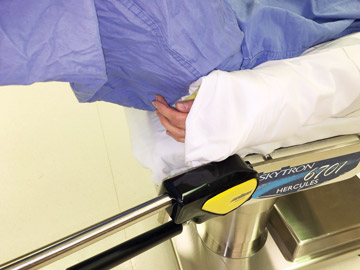From speed bumps and sticky pads to arm tucks and tilt tests, you pull out all the stops to protect patients when you place them in the Trendelenburg position. Here are 6 tips to keep their bodies from sliding and their skin from shearing.
1. Lithotomy-Trendelenburg. Anytime you go into a lithotomy-Trendelenburg position — supine with the legs separated, flexed and supported in raised stirrups — you need to worry about positioning injuries. Most of the time it's a peroneal nerve injury, caused by being up in the stirrups that puts pressure on the lateral side of the legs and peroneal nerve. Check to see that the stirrups are in the right place and that the patient is positioned at the bottom of the bed.
"I make sure that the articulating aspect of the stirrup that's attached to the bed is at the level of the hip joint of the patient," says Taylor Brueseke, MD, of St. Joseph Hospital in Orange, Calif. "So, when I move the foot up, the leg is rotating from that same point of rotation."
When positioning patients, Dr. Brueseke thinks about the skeleton rather than the skin. He uses the ischial tuberosity — the bony part of the buttocks — as a guide to make sure it's supported and located at the edge of the table so that the lower back will stay neutral and not hyperextend, which can cause back pain after surgery. Also, keeping the legs in an ergonomically appropriate position while in the stirrups helps prevent injuries.
"As we move the legs, from high lithotomy to low lithotomy, we're not damaging any nerves and we're keeping the patient in the appropriate physiological position," says Mini "Dr. Mini" Somasundaram, MD, of Comprehensive Women's Care in Columbus, Ohio.
When adjusting or re-positioning one side of the patient, be sure to check the opposite side for potential problems.
"When the patient position has been adjusted, whether this is due to table, patient or purposeful staff movement, always check the contralateral side for any issues that may cause an injury," says Brent Klev, MBA, MSN, RN, surgical services nurse manager at South Jordan Health Center in Utah.
.svg?sfvrsn=be606e78_3)


.svg?sfvrsn=56b2f850_5)